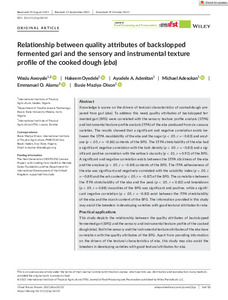| dc.contributor.author | Awoyale, W. |
| dc.contributor.author | Oyedele, H.A. |
| dc.contributor.author | Adenitan, A.A. |
| dc.contributor.author | Adesokan, M. |
| dc.contributor.author | Alamu, E.O. |
| dc.contributor.author | Maziya-Dixon, B. |
| dc.date.accessioned | 2022-01-24T14:29:56Z |
| dc.date.available | 2022-01-24T14:29:56Z |
| dc.date.issued | 2022-01 |
| dc.identifier.citation | Awoyale, W., Oyedele, H.A., Adenitan, A.A., Adesokan, M., Alamu, E.O. & Maziya‐Dixon, B. (2021). Relationship between quality attributes of backslopped fermented gari and the sensory and instrumental texture profile of the cooked dough (eba). Journal of Food Processing and Preservation, 46(1):e16115, 1-14. |
| dc.identifier.issn | 0145-8892 |
| dc.identifier.uri | https://hdl.handle.net/20.500.12478/7317 |
| dc.description.abstract | Knowledge is scarce on the drivers of textural characteristics of cooked dough prepared from gari (eba). To address this need, quality attributes of backslopped fermented gari (BFG) were correlated with the sensory texture profile analysis (STPA) and instrumental texture profile analysis (ITPA) of the eba produced from six cassava varieties. The results showed that a significant and negative correlation exists between the STPA mouldability of the eba and the sugar (p < .05, r = −0.83) and amylose (p < .05, r = −0.86) contents of the BFG. The STPA stretchability of the eba had a significant negative correlation with the bulk density (p < .05, r = −0.83) and a significant positive correlation with the setback viscosity (p < .01, r = 0.92) of the BFG. A significant and negative correlation exists between the STPA stickiness of the eba and the amylose (p < .05, r = −0.84) contents of the BFG. The ITPA adhesiveness of the eba was significant and negatively correlated with the solubility index (p < .05, r = −0.89) and the ash content (p < .05, r = −0.87) of the BFG. The correlation between the ITPA stretchability of the eba and the peak (p < .05, r = 0.83) and breakdown (p < .05, r = 0.88) viscosities of the BFG was significant and positive, while a significant negative correlation (p < .05, r = −0.83) exist between the ITPA stretchability of the eba and the starch content of the BFG. The information provided in this study may assist the breeders in developing varieties with good textural attributes for eba. Practical applications This study depicts the relationship between the quality attributes of backslopped fermented gari (BFG) and the sensory and instrumental texture profile of the cooked dough (eba). Both the sensory and the instrumental texture attributes of the eba have correlation with the quality attributes of the BFG. Apart from providing information on the drivers of the textural characteristics of eba, this study may also assist the breeders in developing varieties with good textural attributes for eba. |
| dc.description.sponsorship | Bill & Melinda Gates Foundation |
| dc.format.extent | 1-13 |
| dc.language.iso | en |
| dc.subject | Cassava |
| dc.subject | Garri |
| dc.subject | Breeding |
| dc.subject | Processing |
| dc.subject | Nigeria |
| dc.title | Relationship between quality attributes of backslopped fermented gari and the sensory and instrumental texture profile of the cooked dough (eba) |
| dc.type | Journal Article |
| cg.contributor.crp | Agriculture for Nutrition and Health |
| cg.contributor.crp | Roots, Tubers and Bananas |
| cg.contributor.affiliation | International Institute of Tropical Agriculture |
| cg.contributor.affiliation | Kwara State University |
| cg.coverage.region | Africa |
| cg.coverage.region | West Africa |
| cg.coverage.country | Nigeria |
| cg.coverage.hub | Southern Africa Hub |
| cg.coverage.hub | Headquarters and Western Africa Hub |
| cg.researchtheme | Nutrition and Human Health |
| cg.identifier.bibtexciteid | AWOYALE:2021b |
| cg.isijournal | ISI Journal |
| cg.authorship.types | CGIAR Single Centre |
| cg.iitasubject | Agronomy |
| cg.iitasubject | Cassava |
| cg.iitasubject | Food Security |
| cg.iitasubject | Plant Breeding |
| cg.iitasubject | Plant Production |
| cg.iitasubject | Value Chains |
| cg.journal | Journal of Food Processing and Preservation |
| cg.notes | Open Access Article; Published online: 27 Oct 2021 |
| cg.accessibilitystatus | Open Access |
| cg.reviewstatus | Peer Review |
| cg.usagerightslicense | Creative Commons Attribution 4.0 (CC BY 0.0) |
| cg.targetaudience | Scientists |
| cg.identifier.doi | https://dx.doi.org/10.1111/jfpp.16115 |
| cg.iitaauthor.identifier | Wasiu Awoyale: 0000-0002-3635-1414 |
| cg.iitaauthor.identifier | Hakeem A. OYEDELE: 0000-0001-5734-9156 |
| cg.iitaauthor.identifier | Michael Adesokan: 0000-0002-1361-6408 |
| cg.iitaauthor.identifier | Alamu Emmanuel Oladeji: 0000-0001-6263-1359 |
| cg.iitaauthor.identifier | Busie Maziya-Dixon: 0000-0003-2014-2201 |
| cg.futureupdate.required | No |
| cg.identifier.issue | 1:e16115 |
| cg.identifier.volume | 46 |
| cg.contributor.acknowledgements | The authors acknowledged the CGIAR Research Program’s support on Roots, Tubers and Bananas (RTB), the staff of Food and Nutrition Sciences Laboratory, and the Cassava Breeding Units especially Dr. Ismail Rabbi, of IITA, Ibadan, Nigeria. |

